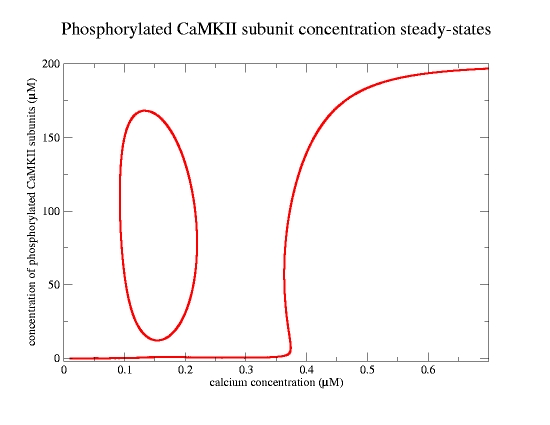This is the readme for the model associated with the paper:
Graupner M, Brunel N (2007) STDP in a bistable synapse model based on
CaMKII and associated signaling pathways. PLoS Comput Biol 3:e221
Abstract:
The calcium/calmodulin-dependent protein kinase II (CaMKII) plays a
key role in the induction of long-term postsynaptic modifications
following calcium entry. Experiments suggest that these long-term
synaptic changes are all-or-none switch-like events between discrete
states. The biochemical network involving CaMKII and its regulating
protein signaling cascade has been hypothesized to durably maintain
the evoked synaptic state in the form of a bistable switch. However,
it is still unclear whether experimental LTP/LTD protocols lead to
corresponding transitions between the two states in realistic models
of such a network. We present a detailed biochemical model of the
CaMKII autophosphorylation and the protein signaling cascade governing
the CaMKII dephosphorylation. As previously shown, two stable states
of the CaMKII phosphorylation level exist at resting intracellular
calcium concentration, and high calcium transients can switch the
system from the weakly phosphorylated (DOWN) to the highly
phosphorylated (UP) state of the CaMKII (similar to a LTP event). We
show here that increased CaMKII dephosphorylation activity at
intermediate Ca(2+) concentrations can lead to switching from the UP
to the DOWN state (similar to a LTD event). This can be achieved if
protein phosphatase activity promoting CaMKII dephosphorylation
activates at lower Ca(2+) levels than kinase activity. Finally, it is
shown that the CaMKII system can qualitatively reproduce results of
plasticity outcomes in response to spike-timing dependent plasticity
(STDP) and presynaptic stimulation protocols. This shows that the
CaMKII protein network can account for both induction, through
LTP/LTD-like transitions, and storage, due to its bistability, of
synaptic changes.
Usage notes:
Please note that this (ode) file allows to compute the steady-states
of the CaMKII phosphorylation level with respect to calicum. The
parameter used here allow to reproduce the data shown in Fig.3C by the
blue line (p.2303) in the above mentioned paper.
The steady-state diagram consits of two separate branches which have
to be computed separately. This is the case since the initial point
(specified by 'init' in the .ode files) has to be a fixed point on
the respective branch. Two files are provided to compute the upper
(including the UP state) and the lower (including the DOWN state) branch.
The computation starts at Ca_0 = 0.2 \mu M for the former and at
Ca_0 = 0.01 \mu M for the latter.
Note however that all the dynamic simulations were not done with xppaut.
The dynamics of the CaMKII-system has been implemented in a C++ code.
Please contact the authors for further informations.
both files are set to run:
1. start xppaut and load file
$ xppaut
2. lauch auto
click -> File -> AUTO
3. run auto
click -> Run -> Steady State
and you will get the fix-points of the system with the bistability
(see ode file for more usage information).
 This model was submitted by Dr. Graupner.
This model was submitted by Dr. Graupner.
 This model was submitted by Dr. Graupner.
This model was submitted by Dr. Graupner.
This model was submitted by Dr. Graupner.